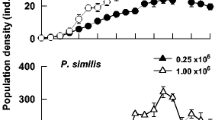Abstract
We performed life-table experiments with two species of the littoral rotifers Lecane luna (O.F. Müller, 1776) and Lecane quadridentata (Ehrenberg, 1832). Three different temperatures (20, 25 and 30°C) and food concentrations of Nannochloris oculata (1×107, 5×106, and 1×106 cells ml-1) were investigated. We found important differences between both species in all the treatments regarding offspring sizes, hatching percentages, life span and reproductive rates. Our data on hatching percentages of asexual eggs suggested that the optimal temperature for both species is in the 20–25°C range. On the other hand, reproductive data placed the optimal temperature near 25°C. This information can be used to develop aquatic toxicology tests with littoral species.
Similar content being viewed by others
References
Begon, M., J. L. Harper, C. P. Townsend, 1996. Ecology: Individuals, Populations, and Communities, 3rd edn. Blackwell Scientific: 1068 pp.
Doohan, M., 1973. An energy budget for adult Brachionus plicatilis Müller. Oecologia 13: 351–362.
Galkovskaya, G. A., 1983. On temperature acclimation in an experimental population of Brachionus calyciflorus. Hydrobiologia 104: 225–227.
Galkovskaja, G. A., 1987. Planktonic rotifers and temperature. Hydrobiologia 147: 307–317.
Gilbert, J. J. & D. K. Schreiber, 1995. Induction of diapausing amictic eggs in Synchaeta pectinata. Hydrobiologia 313/314: 345–350.
Halbach, U., 1970. Die Ursachen der temporalvariation von Brachionus calyciflorus Pallas (Rotatoria). Oecologia 4: 262–318.
Hummon, W. D. & D. P. Bevelhymer, 1980. Life table demography of the rotifer Lecane tenuiseta under culture conditions and various age distributions. Hydrobiologia 70: 25–28.
Krebs, C. J., 1985. Ecología: Estudio de la distribución y la abundancia, 2nd edn. Ed. Harla. México D.F., Mexico: 753 pp.
Krebs, C. J., 1994. Ecology, the Experimental Analysis of Distribution and Abundance. 4th edn. Harper-Collins Publ: 801 pp.
May, L., 1987. Effect of incubation temperature on the hatching of rotifer resting eggs collected from sediments. Hydrobiologia 147: 335–338.
Nichols, H. W., 1973. Growth media - freshwater. In J. R. Stein (ed.), Handbook of Phycological Methods. Cambridge University Press: 7–24.
Nogrady, T., R. L. Wallace & T.W. Snell, 1993. Guides to the identification of the microinvertebrates of the continental waters of the world, Volume 4: Rotifera. SPB Academic Publishing: 142 pp.
Rao, T. R. & S. S. S. Sarma, 1988. Effect of food and temperature on the cost of reproduction in Brachionus patulus (Rotifera). Proc. Indian natn. Sci. Acad. B54, No. 6: 435–438.
ReVélle, P. & Ch. ReVélle, 1992. The Global Environment: Securing a Sustainable Future. Jones and Bartlett Publishers, Inc. London, England: 480 pp.
Rico-Martínez, R. & S. I. Dodson, 1992. Culture of the rotifer Brachionus calyciflorus Pallas. Aquaculture 105: 191–199.
Sarma, S. S. S. 1985. Effect of food density on the growth of the rotifer Brachionus patulus Müller. Bull. bot. Soc. Sagar 32: 54- 59.
Sarma, S. S. S. & T. R. Rao, 1990. Population dynamics of Brachionus patulus Müller (Rotifera) in relation to food and temperature. Proc. Indian Acad. Sci. (Anim. Sci.) 99(4): 335–343.
Segers, H., 1995. Guides to the identification of the microinvertebrates of the continental waters of the world: Volume 2. Rotifera: The Lecanidae (Monogononta). SPB Academic Publishing: 226 pp.
Silva-Briano, M., 1992. Preliminary study of the zooplankton of Mexico. End of course report of the International Training Course 'Lake Management: A Tool in Lake Management'. State University of Ghent, Ghent, Belgium: 12 pp (23 illustrations).
Snell, T. W. & B. D. Moffat, 1992. A 2-d life cycle test with the rotifer Brachionus calyciflorus. Envir. Toxicol. and Chem. 11: 1249–1257.
Snell T. W. & C. R. Janssen, 1995. Rotifers in ecotoxicology: a review. Hydrobiologia 313/314: 231–247. Standard Methods, 1995. 19th edn: 258 pp.
Stemberger, R. S., 1979. A guide to rotifers of the Laurentian Great Lakes. U.S. EPA publication: EPA/600/4–79/021, Washington, DC: 186 pp.
United States Environmental Protection Agency, 1985. Methods for measuring the acute toxicity of effluents to freshwater and marine U.S. EPA publication: EPA-600/4–85–013, Washington, DC.
Walz, N., 1983. Individual culture and experimental population dynamics of Keratella cochlearis (Rotatoria). Hydrobiologia 107: 35–45.
Author information
Authors and Affiliations
Rights and permissions
About this article
Cite this article
Pérez-legaspi, I.A., Rico-martínez, R. Effect of temperature and food concentration in two species of littoral rotifers. Hydrobiologia 387, 341–348 (1998). https://doi.org/10.1023/A:1017099906853
Issue Date:
DOI: https://doi.org/10.1023/A:1017099906853




